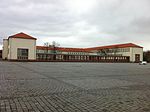Halle-Neustadt (German pronunciation: [ˈhalə ˈnɔɪ̯ˌʃtat] (listen); popularly known as HaNeu /haːˈnɔɪ̯/, like Hanoi) was a city in the German Democratic Republic (East Germany). It was established as a new town on 12 May 1967, as an independent and autonomous city. The population in 1972 was 51,600 and in 1981 was more than 93,000. On 6 May 1990, Halle-Neustadt merged back into Halle again. The population has halved since then and was about 45,157 inhabitants on 31 December 2010. Halle Neustadt has been praised for being “sustainable” as a result of its urban planning, which includes high density living, a tram line serving the central corridor and the regional suburban rail system (S-Bahn).
The development itself extends east to west for approximately 4 km and is approximately one kilometre wide. Much of the housing is located within the international mass transit standard of 400 metres from a station on the core axis. Virtually all housing is high rise, with some towers reaching 11 floors. Medium rise buildings tend to have six floors without lifts.
Since the dissolution of East Germany and the subsequent deconstruction of much of East German industry, the town has, like many other East German towns, suffered from population loss. There are a number of empty buildings, including high rise buildings, and even some that have been gutted. The city of Halle itself has lost a quarter of its population in barely 15 years — and it appears that most of the exodus has come from Halle Neustadt. Residents have taken the opportunity to move to the city itself or to the suburban communities that ring Halle.
Some residential buildings are being redeveloped by the private sector. There is what appears to be a privately developed shopping centre in the core, with a multistory car park and numerous businesses. Parking is now provided adjacent to the remaining occupied apartment buildings. In the beginning, garages were provided on the eastern fringe of the development for those few privileged enough to have cars.






